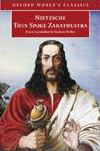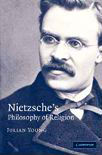Book Review
-
Nietzsche's New Darwinism By John Richardson
Reviewed by Bradley Park
St. Mary's College of Maryland
You may download the entire book review as Adobe PDF format clicking PDF icon on the left. If you need some clarifications about copyright or usage rights, please contact us at nceditors@ietzschecircle.com.
Page 1 | Page 2 | Page 3 | Page 4
Richardson maintains that Nietzsche’s critiques of pity and altruism involve both a rhetorical moment aimed at freeing one from the herd’s values and a secondary moment challenging the way in which particular values direct our freedom. In the first case, Nietzsche’s polemics may be less a matter of criticizing a particular table of values per se, but of criticizing the underlying cause, i.e., the herd morality, behind why we hold the values we do. In the second case, Richardson holds that Nietzsche’s critiques have an assertive dimension wherein he contests the ways in which specific values curtail our more self-interested drives.
The core project of Nietzsche’s ethics is to redesign our configuration of drives in order to contribute to the aim of self-selection (freedom) and, secondly, to serve a greater health. In Richardson’s narrative, the morality of pity is exapted such that it becomes empathy disciplined by hardness. Nietzsche’s commitments to genealogy and perspectivalism entail a corresponding commitment to empathy as a necessary capacity for the genealogist, who must enter into the valuative stance of the other. According to Richardson, empathy is primarily epistemic for Nietzsche, that is, it plays a diagnostic and an explanatory role within genealogy. His emphasis on hardness, then, is a counter-force to the propensity of empathy to become pity. Unlike empathy, pity represents a purely passive, reactive, and moralistic stance. Empathy focused by a timely hardness represents a disciplined and resolute stance, a form of “tough love” or “bitter medicine,” in view of the self and others. It helps constitute an honesty that does not shrink from the severity of genealogical critique.
Richardson builds his explication of Nietzsche’s selfishness around the notion of a greater health. By this he means that his selfishness does not issue from the ego, but from a deeper form of health, which wills what is truly good for it rather than what it, the ego, merely wants. Similarly, Nietzsche’s rejection of altruism is a rejection of the rational self’s negation of the deeper, more robust, more animal, and more bodily aspects of the self in moral self-sacrifice and asceticism. In the place of empathy, Richardson points to a Nietzschean form of “giving,” as exemplified by Zarathustra and the Sun’s “bestowing virtue.” In this instance, there is no negation of the self qua nihilism, but an overflowing of the self qua surplus.
In terms of politics, Richardson approaches Nietzsche’s political ideas as a “reform of values, […] for the sake of freedom” (200). Moreover, he does not read Nietzsche as endorsing a transcendent authoritarian political project imposed from outside by any particular regime or existing political structure. Rather, he sees Nietzsche as projecting the possibility of certain kind of immanent transfiguration of customs, consciousness, and values—perhaps, what Nietzsche thinks of as a form of “convalescence.” The political project, then, is a diagnostic and analytical examination of the macro level social selective conditions, which are genealogically revealed as undermining or enabling the tasks of self-selection and health. The macro-conditions occupying the center of his political thinking are a critique of bad breeding due to domestication’s skewing of biological selection and an endorsement of rank ordering rather a flattening of social relations qua democracy.
Nietzsche’s discussions about breeding, as well as race, eugenics, and sexual/gender relations, primarily concern an elevation of taste qua biological selection. The main goal, for Nietzsche, is a more critical reproductive taste—one motivated by increased freedom and health, rather than by the interests of the ego and, by extension, the herd. Given the importance that Richardson places on the epistemic power of Rausch (“aesthetic-sexual rush, excitation,”) in the last chapter, it is surprising that it is not more central to his remarks about breeding. If I read his fourth chapter correctly, the epistemic importance of Rausch originates in its bodily roots and its long evolutionary history, which is what makes our aesthetic drives more trustworthy and potentially more critical, i.e., truth discerning, than consciousness or any of our more “mental” drives. In other words, Rausch represents a standpoint that is both immanently available and critical, because it remains at least partly transcendent to the history of domestication (social selection). In view of this account, it seems to me that Nietzsche’s worries about breeding for the “wrong reasons,” that is, breeding motivated by metaphysical and moralistic interpretations of marriage and love, undermines the critical veracity of Rausch by over-writing the biological history that is the source of its epistemic reliability. It seems to me that Nietzsche’s views about breeding are primarily marshaled in defense of what is still wild and Dionysian within this aesthetic-sexual drive. While this reading is rooted in Richardson’s own account, he reserves his discussion of Rausch for the fourth chapter on Aesthetics.
Chapter 4 – “Aesthetics”
One of Richardson’s clear commitments is that Nietzsche never stops caring about truth, even when he is emphasizing the aesthetic. On Richardson’s view, Nietzsche preserves what he sees as a productive tension or agon between his projects of truth and aesthetic value. Richardson further divides the aesthetic component into three aesthetic attitudes, which differ in their basic orientation: (1) the creative (active) attitude towards producing beauty, (2) the receptive (passive) attitude of enjoying beauty, and (3) the discriminative attitude for judging beauty. In each case, he gives an interesting and plausible account of the role these attitudes play in the task of self-selection and the way in which these attitudes remain in contact with the will to truth.
Richardson’s overall account of Nietzsche’s aesthetic view is rooted in the experience of Rausch as the central function of the aesthetic drives. By focusing on Rausch, he is able to give a naturalistic account of the aesthetic by turning, once again, to the way in which our various capacities vis-à-vis the aesthetic can be explained in terms of selected drives. Moreover, given that his account of Rausch is rooted in his etiological theory of drives, it is not surprising that the result of the aesthetic drives is Rausch. But Richardson’s claim is stronger still; he contends that the very function, i.e., identity, of these drives is defined in relation to Rausch.
The biological basis for the importance of aesthetic drives is sexual and reproductive discrimination. According to Richardson, the primary aesthetic attitude is discriminative, because it has been crucial for biological selection that human beings recognize beauty, that is, respond positively to the “rush” (Rausch) of the beautiful, the healthy, the strong, the ascending human: “Our bodies themselves have a taste for certain kinds of beauty—above all the beauty of human bodies” (229). Conversely, we have evolved to be instinctually repelled by the ugly, the harmful, and the dangerous. As Richardson puts it, “we’re mainly bred to find beautiful” (236), which is not only an aesthetic issue, but also an “epistemic ability” (236) to discern fitness. Since our capacity to judge beauty is a biologically selected capacity, it is inextricably tied to truth. In other words, this particular capacity for judgment is rooted in the selective advantage of being right about the fitness of mates. Richardson writes, “what’s been bred into us first is the disposition to respond by Rausch to physical and behavioral features that have been, on average, reliable predictors of health and fitness” (242). He then argues that this discriminative attitude forms the footing of the aesthetic attitudes of receptivity and creativity vis-à-vis beauty.
The fact that our aesthetic drives are fundamentally rooted in sexuality, and by extension fecundity, means that the bodily excitement or stimulation of Rausch is deeply intertwined with a sense of power and creative potency. It also means that Rausch is a basic discriminative capacity for discerning strength and health as powers for creatively engaging the world, which is sharply distinguished from the passive model of disinterested appreciation à la Shaftsbury and Kant. From an evolutionary perspective, our relationship to aesthetic experience is highly motivated. The ability to reliably recognize beauty is a selected epistemic capacity belonging most originally to our animality, to our bodies, rather than to our domesticated humanity, i.e., to our conscious judgment. This is precisely why Nietzsche holds that one needs to trust the feeling of ascendancy or the smell of elevation over and above a calculated and articulate judgment stemming from “later,” and thus more superficial and less trustworthy, cultural norms.
continues on Page 4...
-
Thus Spoke ZarathustraBy Friedrich NietzscheA new translation by Graham Parkes
Oxford University Press, 2005
Reviewed by Horst HutterThis new translation of Nietzsche’s magnum opus is by far the best available in the English language. It should find its way to the desk of all students who do not have access to the original German.
-
Nietzsche’s Philosophy of ReligionBy Julian YoungCambridge University Press, 2006
Reviewed by Horst Hutter,
Concordia UniversityEvery student of Nietzsche in the Anglophone world should read this book. It is a most able treatment of a much-ignored and much-misunderstood topic close to the very heart of the writings of this seminal thinker.
Featured in the Agonist
-
Nietzsche, Music, and Silent Suffering An Introduction
By Yunus Tuncel, The New School University, New York City
...Focus on the impact of Nietzsche's knowledge of music on his philosophy and the development of his thought.
-
Music, Posthumanism and Nietzsche
By Stefan Lorenz Sorgner, Erlangen-Nuernberg
...the first order Empfindung associated to music is the dissolution of individuality which from a posthumanist[1] perspective brings about the realisation of the embeddedness of human beings in this world. Hence, music can bring about more than pain and pleasure in the recipients.
Support Us
Please consider donating! The NC is a not-for-profit organization. As an independent organization that receives no assistance from any institution, the NC relies on your magnanimity to sustain itself. Please help support the activities of the NC with a donation Donations of any kind, whether of money, services, equipment, or in-kind gifts, are all of great necessity and deeply appreciated.
Subscribe
To receive site updates, news, and announcement from NC via email. To do so, you simply need to provide your email address below.







